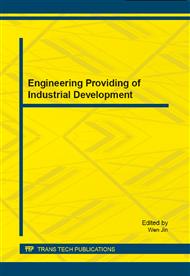[1]
J.H. Simons, Fluorine chemistry . Academic Press(1950).
Google Scholar
[2]
US Public Health Service. Drinking water standards. PHS publication, 956, (1962).
Google Scholar
[3]
WHO Expert Committee on Oral Health Status and Fluoride Use. Fluorides and oral health: report of a WHO expert committee on oral health status and fluoride use. World Health Organization (1994).
DOI: 10.5144/0256-4947.1995.297b
Google Scholar
[4]
Z. Mandinic, M. Curcicb, B. Antonijevicb, M. Carevica, J. Mandica, D. Djukic-Cosicb and C.P. Lekicc, Fluoride in drinking water and dental fluorosis. Science of the total environment 408. 17 (2010): 3507-3512.
DOI: 10.1016/j.scitotenv.2010.04.029
Google Scholar
[5]
J.J. Carrillo-Rivera, A. Cardona and W.M. Edmunds, Use of abstraction regime and knowledge of hydrogeological conditions to control high-fluoride concentration in abstracted groundwater: San Luis Potosi basin, Mexico. Journal of Hydrology. 261(2002).
DOI: 10.1016/s0022-1694(01)00566-2
Google Scholar
[6]
National development and reform commission, ministry of water resources, the ministry of health, environmental protection department. 12th Five-year Plan on Rural Water Supply (2012).
Google Scholar
[7]
M. Mohapatra, S. Anand, B.K. Mishra, D.E. Giles and P. Singh, Review of fluoride removal from drinking water. Journal of Environmental Management. 91. 1 (2009): 67–77.
DOI: 10.1016/j.jenvman.2009.08.015
Google Scholar
[8]
Meenakshi and R.C. Maheshwari, Fluoride in drinking water and its removal. Journal of Hazardous Materials. 137. 1(2006): 456–463.
DOI: 10.1016/j.jhazmat.2006.02.024
Google Scholar
[9]
W. Nigussie, F. Zewge and B.S. Chandravanshi, Removal of excess fluoride from water using waste residue from alum manufacturing process. Journal of Hazardous Materials. 147. 3(2007): 954-963.
DOI: 10.1016/j.jhazmat.2007.01.126
Google Scholar
[10]
S.M. Maliyekkal, S. Shukla, L. Philip and I.M. Nambi, Enhanced fluoride removal from drinking water by magnesia-amended activated alumina granules. Chemical Engineering Journal. 140. 1-3. ( 2008), 183-192.
DOI: 10.1016/j.cej.2007.09.049
Google Scholar
[11]
N. Chen, Z. Zhang, C. Feng, N. Sugiurab, M. Li and R. Chen, Fluoride removal from water by granular ceramic adsorption. Journal of Colloid and Interface Science. 348. 2(2010): 579-584.
DOI: 10.1016/j.jcis.2010.04.048
Google Scholar
[12]
M. Karthikeyan, K.K.K. Satheesh and K.P. Elango, Batch sorption studies on the removal of fluoride ions from water using eco-friendly conducting polymer/bio-polymer composites. Desalination. 267. 1(2011): 49–56.
DOI: 10.1016/j.desal.2010.09.005
Google Scholar
[13]
S. Ghorai and K.K. Pant, Investigations on the column performance of fluoride adsorption by activated alumina in a fixed-bed. Chemical Engineering Journal. 98. 1-2 ( 2004): 165-173.
DOI: 10.1016/j.cej.2003.07.003
Google Scholar
[14]
Y.L. Tang, X.H. Guan, T.Z. Su, N.Y. Gaob and J.M. Wang, Fluoride adsorption onto activated alumina: Modeling the effects of pH and some competing ions. Colloids and Surfaces A: Physicochemical and Engineering Aspects. 337. 1-3 (2009): 33-38.
DOI: 10.1016/j.colsurfa.2008.11.027
Google Scholar
[15]
A. Bhatnagar, E. Kumara and M. Sillanpaa, Fluoride removal from water by adsorption-A review. Chemical Engineering Journal. 171. 3 (2011): 811-840.
DOI: 10.1016/j.cej.2011.05.028
Google Scholar
[16]
V. Ganvir and K. Das, Removal of fluoride from drinking water using aluminum hydroxide coated rice husk ash. Journal of Hazardous Materials. 185. 2-3(2011): 1287-1294.
DOI: 10.1016/j.jhazmat.2010.10.044
Google Scholar
[17]
A.A. Moghaddam and E. Fijani, Distribution of fluoride in groundwater of Maku area, northwest of Iran. Environment Geology. 56. 2 (2008): 281-287.
DOI: 10.1007/s00254-007-1163-2
Google Scholar
[18]
T. Rafique, S. Naseemb , T.H. Usmani, E. Bashirb, F.A. Khana and M.I. Bhangerc, Geochemical factors controlling the occurrence of high fluoride groundwater in the Nagar Parkar area, Sindh, Pakistan. Journal of Hazardous Materials. 171. 1-3 (2009).
DOI: 10.1016/j.jhazmat.2009.06.018
Google Scholar
[19]
N.S. Rao, High-fluoride groundwater. Environmental Monitoring and Assessment. 176. 1-4 (2011): 637-645.
Google Scholar
[20]
S. Battaleb-Looie, F. Moore , H. Jafari, G. Jacks and D. Ozsvath, Hydrogeochemical evolution of groundwaters with excess fluoride concentrations from Dashtestan, South of Iran. Environmental Earth Sciences. 67. 4 (2012): 1173-1182.
DOI: 10.1007/s12665-012-1560-z
Google Scholar
[21]
C. Venkobachar, L. Iyengar, A.K. Mudgal, Household defluoridation of drinking water using activated alumina. 2nd International Workshop on Fluorosis Prevention and defluoridation of Water. (1997): 138-145.
Google Scholar
[22]
R. Buamah, R.A. Mensah and A. Salifu, Adsorption of fluoride from aqueous solution using low cost adsorbent. Water Science and Technology: Water Supply. 13. 2(2013): 238–248.
DOI: 10.2166/ws.2013.016
Google Scholar
[23]
W. Ma, Chemistry and solid water interface adsorption technology. Beijing, Metallurgical Industry Press (2011): pp.203-204.
Google Scholar
[24]
C.R.N. Rao and J. Karthikeyan, Removal of Fluoride from Water by Adsorption onto Lanthanum Oxide. Water Air Soil Pollut. 223. 3(2012): 1101-1114.
DOI: 10.1007/s11270-011-0928-0
Google Scholar
[25]
Jae-Hyun. Kim, Chang-Gu. Lee, Jeong-Ann. Park, In-Kyu. J Kang, Seo-Young. Yoon and Song-Bae. Kim. Fluoride removal using calcined Mg/Al layered double hydroxides at high fluoride concentrations. Water Science and Technology, Water Supply. 13. 2(2013).
DOI: 10.2166/ws.2013.001
Google Scholar


